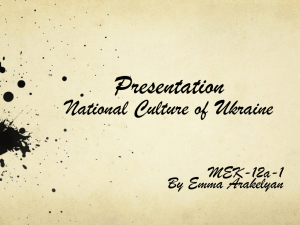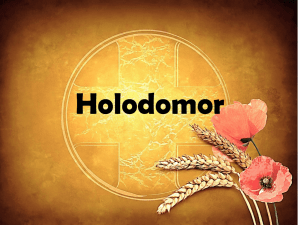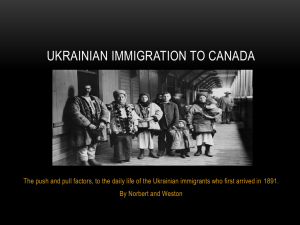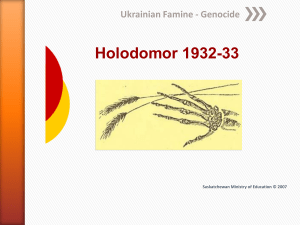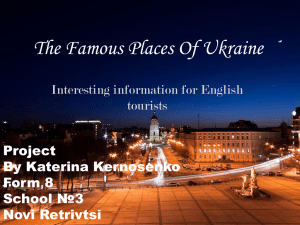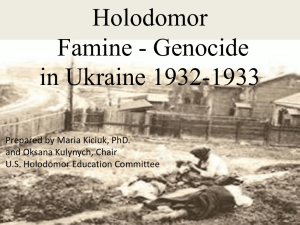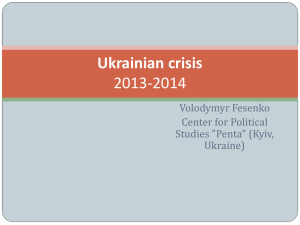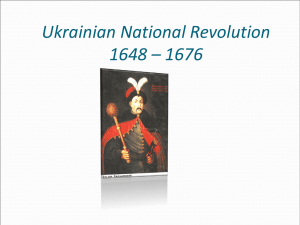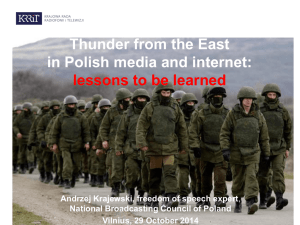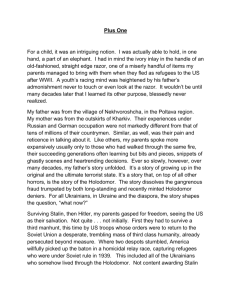Holodomor - 60 slide PPT
advertisement
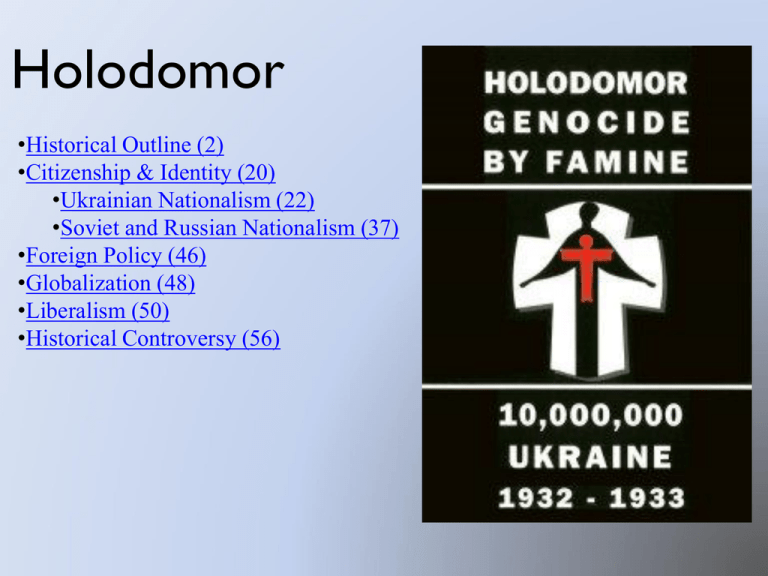
Holodomor •Historical Outline (2) •Citizenship & Identity (20) •Ukrainian Nationalism (22) •Soviet and Russian Nationalism (37) •Foreign Policy (46) •Globalization (48) •Liberalism (50) •Historical Controversy (56) Historical Outline Russian Empire • late to industrialization • late to democratic reform • citizens lacked rights enjoyed by most Europeans Russian Empire Czar Nicholas II • • • • Russia not prepared for WWI problems on the front food riots broke out in the cities forced to abdicate in early 1917 Bolsheviks and Lenin • overthrow provisional government and take control in November 1917 Civil War • fighting takes place across the country against many groups opposed to Bolsheviks • Bolsheviks ultimately win and consolidate power War Communism and Famine • • • • • no private property, nationalization of all industry, rationing of food government monopoly on foreign trade. War Communism & severe drought lead to 10 million deaths Union of Soviet Socialist Republics (USSR) • created in 1922 • Ukrainian Soviet Socialist Republic (Ukrainian SSR) was one of the founding Republics New Economic Policy • introduced by Lenin to rejuvenate the economy • embraced by many in Ukraine Joseph Stalin • ruled the Soviet Union 1928 1953 • rejected the NEP • Stalinism was characterized by terror and totalitarian rule Five Year Plans • organized the economy • peasants forced to give up land and join collective farms • goal was to quickly industrialize • needed to sell grain to buy parts Peasants Reject Collectivization • many burn their crops and livestock rather than hand them over Kulaks • Kulaks were the most successful farmers under the New Economic Policy • Bolsheviks knew they would be the strongest opponents of collectivization • They were 'eliminated' as a social class Attack on Peasants • those resisting collectivization are persecuted • Kulaks are arrested, exiled, sent to prison, tortured or killed Great Depression 1930s • hardship around the world • wheat prices to drop • lower prices affected the first Five Year Plan • government increased quotas Food Becomes State Property • On August 7, 1932 a law came into force that stipulated that all food was state property • peasants unable to meet quotas were stripped of all foodstuffs Starving Peasants • forbidden to take food from the field • forbidden to flee the region or leave the country • shot for looking for food Ukrainian Cities • also saw famine as rations were cut off to many parts of the country • urban workers were encouraged to see themselves as the leaders the revolution Death By Famine • By 1933, 25,000 were starving to death per day. Diseases were spreading • incidents of cannibalism • almost no one outside Ukrainian SSR knew Citizenship and Identity Citizenship and Identity Ukrainian Nationalism Kieven Rus’ • first Eastern Slavic state, Kievan Rus’ • late 9th to mid 13th centuries Cossacks • large influence on Ukrainian culture • Bohdan Khmelnytsky was a famous Cossack who tried to unite Ukrainians • Taras Shevchenko • • • • • • a writer and artist who lived in the 1800s helped form Ukrainian national consciousness inspired revival of Ukrainian culture. called for more autonomy for the regions served time in jail for his beliefs. Today he has become an almost iconic figure Divided People • Prior to World War I, the area that is now Ukrainian Republic was divided between the Russian and AustroHungarian Empires • Successor States after the war did not include Ukraine Union of Soviet Socialist Republics (USSR) • created in 1922 • Ukrainian Soviet Socialist Republic (Ukrainian SSR) was one of the founding Republics The Polish–Ukrainian War • 1918 and 1919 • played a role in the development of Ukrainian nationalism • Ukraine was defeated • deepened feelings of patriotism • Eastern Galicia later became part of Ukrainian SSR and remains a part of the Ukrainian Republic today. Expressions of Ukrainian National Culture • were allowed under the policy of Korenization until 1930 Ukrainian National Orthodox Church • important national symbol for Ukrainians • Created in the 1920s • Allowed to flourish to undermine Russian Orthodox Church Stalin reverses Korenization • state identifies Ukrainian bourgeois nationalism as major problem End of the Soviet Union • Fifteen new countries created when Soviet Union disbanded at the end of 1991 • Ukraine becomes independent nationstate Challenges of Independence • Orange Revolution in 2004-2005 Relationship to Russia • Ukrainians struggle to define their relationship with Russia Ukraine Today • Orthodox Christianity • Eastern Catholicism • Both important influence on culture Ukrainian Cultural Practices • • • • • • • • • • food preparation embroidery weaving songs stories lace-making pysanky dance music "Razom nas bahato, nas ne podolaty" Russian and Soviet Nationalism/Ultra Nationalism and Ukraine What is Ultranationalism? • • • • • authoritarian organizations/governments anti-immigrant scapegoating indoctrination propaganda Russian Empire • Romanov Dynasty • Orthodox Church • Russification promoted Russian Culture throughout the empire Russian Empire Communism and Internationalism • the new Soviet government was united by ideology not ethnicity Communism as basis for National Identity • Bolsheviks though communism would spread around the world Sovietization • led to Russians taking important positions • elimination of any threats to government Ukraine and Russia • a challenging relationship Ukrainian SSR • lacked power • lacked influence Foreign Policy • the actions a nation takes in relation to other nation-states or international organizations The Holodomor and Foreign Policy • What policies should Canada and/or the international community have changed? • Could actions have been taken to prevent or lessen the effects of the Holodomor? • What principles should we follow in creating our foreign policies? • Does humanitarianism trump national sovereignty in the international system? • Is there a point at which the international community should intervene in the affairs of another country? • Who should make these decisions? Globalization Globalization • the process by which the world’s citizens are becoming increasingly connected and interdependent • Bolsheviks tried to increase connectivity & interdependence among people of the Soviet Union Principles of Liberalism • • • • • • • • • freedom equal rights liberal democracy liberal democracy free and fair elections human rights capitalism free trade freedom of religion Classical Liberalism and Russia • Russia was slow to embrace liberal ideas and principles Russia and Liberalism • Russians have never been exposed to liberal principles for a long period • Many Russians demanded a move toward liberal principles after the 1905 uprising Totalitarian Communism • rejection of liberalism To what extent should the government be involved in the economy? Communism • government control of the means of production Historical Controversy • Was the Soviet government intent on destroying Ukrainian nationalism? • Should the victims of the Holodomor be seen as primarily Ukrainians or as peasants? • How many people actually died in Ukraine during the Holodomor? • How many people died in other Soviet Republics during this time due to collectivization? • What motivated the decisions of the central government / Stalin? Consensus • a famine occurred in Ukraine between 1932-33 • the primary cause was forced collectivization • most of the victims were ethnic Ukrainian Genocide • the deliberate and systematic destruction, in whole or in part, of an ethnic, Race (classification of humans), religious, or national group Raphael Lemkin • developed and promoted concept of genocide The Holodomor Was a Genocide Was Not a Genocide •government’s attack on political, cultural and religious elites •the government’s destruction of the Ukrainian churches •policies aimed specifically at Ukraine that removed foodstuffs from starving peasants •the dispersion of Ukrainians to other parts of the Soviet Union •huge influx of Russians to Ukrainian SSR •government’s stated policy of elimination of the Kulaks as a social class and the categorization of so many Ukrainians as Kulaks •millions of non-Ukrainian Soviet citizens also died during the famine •disregard for the lives of the people in the pursuit of economic goals •Soviet Union saw such tremendous loss of life in its first 30 years due to the totalitarianism and the Holodomor is best interpreted as part of this •Stalin alone is believed to be responsible for at least 20 million Soviet citizens – some estimates go as high as 60 million Recognition of the Holodomor • 2006 - Ukrainian parliament pass law recognizing Holodomor as genocide • 2008 European Parliament recognizes Holodomor as crime against humanity

